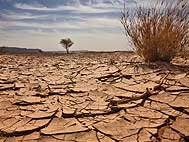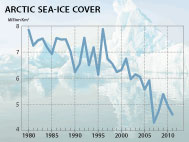| SEARCH |
-

Nov 17, 2015
Reflections on a three-decade legacy
The International Geosphere-Biosphere Programme (IGBP) will come to a close at t...
-
Nov 17, 2015
Use of and access to content on this website
Text and images produced by IGBP in house are free to use with appropriate credi...
-
Nov 12, 2015
Bella Gaia performance and panel discussion to mark IGBP's closure
A musical performance by Bella Gaia will celebrate the achievements and legacy o...
-

Towards Future Earth:
evolution or revolution?
During its three decades of existence, the International Geosphere-Biosphere Pro...
-
A personal note on IGBP and the social sciences
Humans are an integral component of the Earth system as conceptualised by IGBP. João Morais recalls key milestones in IGBP’s engagement with the social sciences and offers some words of advice for Future Earth.
-
IGBP and Earth observation:
a co-evolution
The iconic images of Earth beamed back by the earliest spacecraft helped to galvanise interest in our planet’s environment. The subsequent evolution and development of satellites for Earth observation has been intricately linked with that of IGBP and other global-change research programmes, write Jack Kaye and Cat Downy .
-
Deltas at risk
Around 500 million people worldwide live on deltas, but many of the world's deltas are sinking due ...
-
Climate change: the state of the science
A new data visualization released on the first day of the plenary negotiations at the UNFCCC’s clima...
-
Climate Change:
the State of the Science
Videos now online from the Stockholm public forum to mark the launch of the IPCC's climate report, 2...

Urban air pollution:
a new look at an old problem
Tong Zhu is Co-Chair of IGAC, State Key Laboratory for Environmental Simulation and Pollution Control, College of Environmental Sciences and Engineering, Peking University, Beijing, China.
Liisa Jalkanen is Chief of the Atmospheric Environment Research Division (AER) of the World Meteorological Organization (WMO).
Those residing in other cities aren’t so lucky. Two recent media articles highlighted the air pollution in Beijing and Salt Lake City, two cities on opposite sides of the world. In both cities, the combination of emissions and weather conditions leads to smog. And despite the advances made by London and Los Angeles, the concentrations of particulate matter in these cities remain higher than the limits set by the World Health Organization (WHO; Figure 1).
Air pollution is clearly a pernicious problem and its health impacts are set to worsen as several regions of the world urbanise rapidly. A recent report by the Organisation for Economic Co-operation and Development (OECD) says that by the year 2050, outdoor air pollution is projected to be the world’s top environmental cause of mortality, ahead of dirty water and lack of sanitation (OECD 2012). But human health is just one dimension of air pollution. Unclean air also affects crop growth and reduces the productivity of agriculture (for example, Shindell et al. 2012). It affects climate in a complex manner. Understanding the types and spatio-temporal patterns of urban air pollution is crucial to exploring its implications for human and ecosystem health, food security and climate.
In September 2012, the World Meteorological Organization and IGBP’s International Global Atmospheric Chemistry (IGAC) project published the first international assessment of available information on air pollution in major urban agglomerations. The report entitled The Impact of Megacities on Air Pollution and Climate examined data from Africa, Asia, South America, North America and Europe. It concluded: (1) air pollution continues to be a serious problem across the world; (2) the amount of scientific knowledge varies greatly between megacities; (3) there is a clear opportunity to translate knowledge from well researched urban areas to less researched urban areas to mitigate air pollution; and (4) large urban agglomerations may be the best places to realise the co-benefits of simultaneously controlling air pollution and mitigating climate change.
Air pollution typically refers to a set of common substances – also known as criteria pollutants – that have demonstrable impacts on human health and ecosystems. The main culprits are lead (Pb), carbon monoxide (CO), sulphur dioxide (SO2), nitrogen dioxide (NO2), ozone (O3) and particulate matter (PM). Particulate matter in the form of soot and other small particles floating in the air is usually classed as PM2.5 (particles with diameters smaller than 2.5 micrometres) or PM10 (particles with diametres less than 10 micrometres). Both affect human health as well as climate. We can see from Figure 1 that across 26 cities, despite large differences in PM10 concentrations, even the most developed cities approach or exceed WHO air-quality guidelines.
WHO estimates that air pollution causes more than 2 million premature deaths each year (WHO 2006). In 1987, WHO published Air Quality Guidelines for Europe. In 2005, following important new research from low- and middle-income countries, it released new Air Quality Guidelines for four common pollutants (PM, O3, NO2, and SO2) that are intended to inform policymakers on appropriate targets related to air-quality management (Table 1; WHO 2006).
Major international events have often helped draw attention to air-quality issues and attract international research efforts. For example, in the run-up to the 2008 Beijing Olympics an international collaborative research project, Campaigns of Air Quality Research in Beijing and Surrounding Regions (CAREBEIJING), was implemented. The project was designed to study the regional air pollution processes that affect air quality in Beijing and to formulate air-pollution control strategies for the Olympics. When considered on an average annual basis, the air quality in Beijing has certainly improved although the recent smog suggests that there is some distance to travel.
Ultimately, however, the old adage “You can’t manage what you can’t measure” applies here. Successful implementation and enforcement of air-quality measures is dependent on access to scientific information. The megacities assessment clearly shows the disparity in scientific knowledge across large cities. Cities that have had access to high-quality information – Los Angeles, for example – have benefited. Could newer cities learn from the experience of older cities to avoid teething troubles?
Experience shows that this can indeed be the case. A prime example is shown in Figure 2, which shows how ozone and PM levels changed through time in three similarly sized megacities: Los Angeles, Mexico City and Beijing. During the time period depicted in the figure, each city had a population within ± 40% of the average of the three cities. In Los Angeles, ozone concentrations peaked in the early 1970s and have been decreasing over the past four decades. We can see that the ozone levels in Mexico City never reached the peaks of Los Angeles and levels fell faster. Today, the ozone and PM concentrations in Los Angeles and Mexico City are nearly the same. Mexico City avoided severe air pollution by translating the lessons of Los Angeles to implement emission controls.
Beijing, however, seems to be on a different track. PM concentrations remain higher than the two other cities but are decreasing. In contrast, ozone concentrations, which have been low, are rising. As mentioned earlier, Beijing has taken numerous measures during the past few years to control air pollution. Assessing how these measures are working will not only help Beijing to fine-tune its policies but will also hold lessons for more recently urbanising centres.
Although the impact of big cities on local air quality has long been recognised, the impacts on regional and global climate are beginning to receive increased attention. We know now that air pollutants can drive climate change in complex ways (see Arneth et al. 2009, for example). Many pollutants (such as sulphur dioxide) form tiny droplets that deflect incoming solar radiation and tend to cool the climate. Pollution control policies that reduce the atmospheric concentrations of such substances can in fact lead to warming. Other pollutants – black carbon (soot) in particular – can absorb incoming solar radiation and lead to warming. Because black carbon is also a significant health hazard, policies aimed at controlling the emissions of this substance could lead to a win-win scenario (see page 9 of this issue).
With this emerging understanding, there is little justification for keeping air pollution and climate change in separate boxes. These are issues with overlapping temporal and spatial scales and should be addressed in an integrated manner. It has been argued that megacities and other large urban agglomerations are the best places to realise the co-benefits of simultaneously controlling air pollution and tackling climate change.
The WMO/IGAC Impacts of Megacities on Air Pollution and Climate assessment sought to evaluate the current state of knowledge and identify gaps. It reveals that the quality and quantity of available information is highly variable, with air pollution in some cities being much better characterised than that in others. The gaps underscore the need for continued international efforts to measure urban air quality and use this information to improve air quality while simultaneously mitigating climate change.


Arneth et al. (2009) Science 326: 672-673.
OECD (2012) OECD Environmental Outlook to 2050: The Consequences of Inaction. 350 pp. doi: 10.1787/9789264122246-en
Shindell D et al. (2012) Science 355: 183-189.
WHO (2006) WHO Air Quality Guidelines for Particulate Matter, Ozone, Nitrogen Dioxide and Sulfur Dioxide. 22 pp.
http://whqlibdoc.who.int/hq/2006/WHO_SDE_PHE_OEH_06.02_eng.pdf
Zhu T et al. (2012) WMO/IGAC Impacts of Megacities on Air Pollution and Climate. GAW Report 205. 299 pp. http://www.igacproject.org/sites/all/themes/bluemasters/images/GAW Report 205.pdf
BBC article on the high air pollution in Beijing in January this year.
http://www.bbc.co.uk/news/world-asia-china-20998147; accessed on 1 March 2013
The New York Times article on smog problems in Salt Lake City.
http://www.nytimes.com/2013/02/24/us/utah-a-nature-lovers-haven-is-plagued-by-dirty-air.html?_r=0; accessed on 1 March 2013
IGBP closed at the end of 2015. This website is no longer updated.
-

Global Change Magazine No. 84
This final issue of the magazine takes stock of IGBP’s scientific and institutional accomplishments as well as its contributions to policy and capacity building. It features interviews of several past...
-

Global Change Magazine No. 83
This issue features a special section on carbon. You can read about peak greenhouse-gas emissions in China, the mitigation of black carbon emissions and the effect of the 2010-2011 La Niña event on gl...
-
INTERGOVERNMENTAL PANEL ON CLIMATE CHANGE:
How green is my future?
UN panel foresees big growth in renewable energy, but policies will dictate just how big.
-
UK:
'The Anthropocene: a new epoch of geological time?'
Royal Society, Philosphical Transactions A























